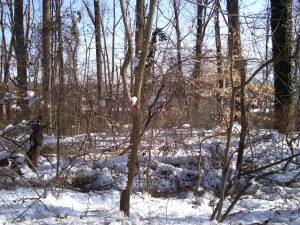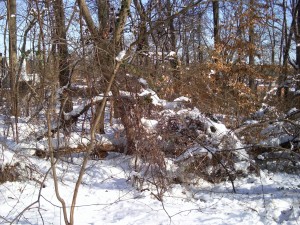
Now is a great time to get outside and tromp through the deep snow and remove Multi-flora Rose.  The snow is starting to lose its charm. We have been finding more and more native trees and shrubs in Morris Park  that have broken and split under the weight of the snow.
Its an ongoing inventory of destruction. A whole plant splits at the trunk. What to do? Prune it?
Do nothing is the conclusion and here is why: Â The bark remains intact, and there is a whole network of buds ready to go to leaf and photosynthesize in the coming season. Even with the split trunk, the plant will still go to leaf and subsist. The energy created by this process will help the plant rebuild its structure. Once this process has been established and new growth commences as the season progresses, the plant will abandon the damaged section, which will die and rot off eventually. Â We examined many spicebushes (Lindera benzoin) today and could read the history of each plant by looking at the branches.
Every specimen tells its own story, and when analyzed as a group, simple conclusions can be ascertained: Branches of this shrub are being split every winter. Â These branches continue to live, but only for one season. Â They then die, and turn red. The plant sends up robust new shoots. Eventually the dead branch falls off, and the trunk heals the scar. Sometimes the plant does just die. Most of the time it continues to live, regrowing what has been lost.
Winter is a great time for this study and reflection of the bones of  the trees and shrubs.
Multiflora Rose, a difficult exotic invasive, has created impenetrable thickets throughout  Morris Park, crowding out native plants, and reducing the productivity of the natural ecosystem.  This plant has sharp thorns that easily penetrate clothing, making it difficult to remove.  However, in the winter, this plant is dormant and more easily accessed.
With thick winter clothing and work gloves, we are able to move right into the thickets and cut down the descending canes enough to access the ascending sections of this arcing menace. Â We leave the rooted stub in place until the snow melts and the soil is wet and friable, so we can easily pull out the entire plant for disposal. Â Removal of the roots is essential for the effective control of this plant. The roots are considered propagules, which are any part of a plant that can reproduce into a new plant.

In the immediate foreground is a spicebush that was covered with invasive vines last May, until we removed them. It survived this snow event very well. However, much of its bark was rubbed off by deer rubbing their antlers, called “buck rub” and now the bush is at risk of death. The arched figure in the back-round is a Black Cherry pulled down by a mass of grape vines and the weight of the snow. Today we removed all of the vines threatening this tree, which began to perk up, rising from its prone state.
The snow is so deep that it is hard to move, so we had to stay in one spot while we worked.  We still were able to begin the abatement of  a thicket of Multiflora Rose (Rosa multiflora),  and a stand of Burning Bush (Euonynmus alatus).  Our feet were cold at the end of the afternoon, but  we were able to be outside for the duration of this winter day.



The plant rebuilding you describe under the Groundhog storm entry is called “compartmentalization.” The tree contains the damage and moves on, healing the split trunk. Some oaks in the south, such as Live Oak, are good at compartmentalization, whereas the Water Oak is very poor at compartmentalization, and any opening through the bark is a source of continual degradation of the tree structure. Live oaks live 200-300 years, Water oaks live 50-70 years. Compartmentalization is the difference.
A very effective product for killing invasive shrubbery is Garlon 4. I learned about it from Asplundh Tree Service, (based in Pennsylvania), as they applied it to the stumps of some trash trees they took out on my property under the power lines. It has a gree dye added to it, and I was concerned they put down a copper product which would keep killing everything that tried to grow there. the Asplundh superintendent was very helpful in clarifying my mis-conception. If the product is applied to a fresh cut stump of a shrub, the roots die. Results are immediate–once it is applied the roots have no chance to send forth a new shoot. Boom! I don’t know where to locate the product, but going online may be a likely first step. It probably would not work in a winter-dormant trunk/stump.
Thank you for the tip. We are not allowed to use any chemical pesticides for our volunteer work under Fairmount Park’s Volunteer program. However Fairmount Park has trained Environmental Technicians who employ the use of pesticides for challenging populations of invasives.